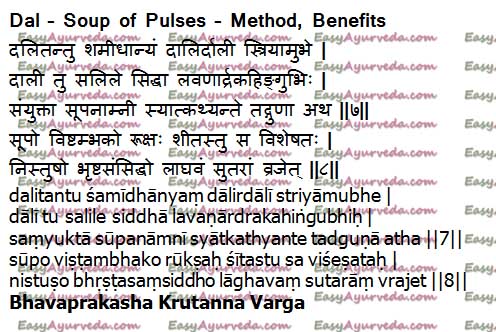Daal – Soup Of Pulses – Preparation Method, Health Benefits
By Dr M S Krishnamurthy MD (Ayu), PhD.
Ayurveda system emphasizes the role of food and habits in every context of health and diseases. On many occasions, specific foods are used in conjunction with medicines for treating disorders.
In Ayurveda food is appreciated as Mahabhaishajya – major medication!
Here is a classical dietetic preparation Daal which has specific benefits and some disadvantages
Table of Contents
Classical reference
Daal / Daali (Soup of Pulses):

Definition
The pulses like green gram, black gram, yellow gram, masoor daal etc are cooked well and the dish prepared out of this is called Daal. It is also called by other names like Dali, Daali, Daaltovai, Daltovi etc.
In fact two separated sides of the pulses are called Dal in Sanskrit and hence the name Daal is given for this recipe.
Method of preparation
Approximately 50 gram of any specified pulse is taken and washed. This is cooked well with about 400 ml of water.
To this rock salt – 5-8 grams
Fresh ginger – 3- 4 grams
and asa foetida (heeng) fried in ghee – 250 mg – 500 mg are added and further cooked.
Cooking is continued till it is thicker in consistency. This is a kind of soup preparation. So, some name it as Daal soup also.
As per Bhojana Kutuhala Dal cooked in water with addition of salt, wet ginger and asafetida is called supa
Qualities, actions, application
Qualities:
Ruksha (dry) and Sheetala (cold )in nature.
Actions:
Vishthambha karaka (block the channels)
Application:
Due to its dry and cold nature it is Vatavardhaka (aggravates vata disorders). So, in spite of the additive salt, ginger and asafetida it may provoke Vata Dosha. Hence it is to be avoided in all neuromuscular disorders, arthritis, body ache, back ache, cervical spondylosis etc.
Also, it is better to be avoided in the patients who are suffering from constipation, distension of abdomen, burping, head ache, acid peptic disorders, pedal edema, abscess, swelling etc. But this can be safely advised and used among the patients who are having good body strength, digestive capacity, Kapha constitution etc.
In mild Pitta involved conditions can also be used. Where as if the same is consumed by the paittic individulas it may increase the dryness of the pitta (which has unctuous property) and lead to fever or heaviness of the upper part of abdomen and sour burping.
Kapha dominant pitta patients can use this safely and even for prolonged period. But if Vatic people or individuals suffering from vatic disorders have the urge to take Daal, better to take this recipe by adding lemon juice. Or else immediately after Daal intake sour bettermilk can be consumed which will counteract the adverse effects of Daal.
In case of adverse reactions or side effects are caused due to Daal, depending upon the nature of the complaints Dhanvantari vati, Chitrakadi vati, Hingwastaka choorna, Takrarishtha, Lavana bhaskara choorna etc can be used on due consultation with the physician.
Because Daal can increase Vata Dosha, should Vata persons avoid it completely?
It is true that Daal can increase Vata. But if it is cooked with sesame oil and if some spices are added to it, then its Vata increasing action can be reduced to some extent. Then it can be consumed without much issues, by a Vata person.
Click to consult Dr MS Krishnamurthy MD(Ay), PhD.








One comment
MITA
thanks, very nice for vegeterian people.